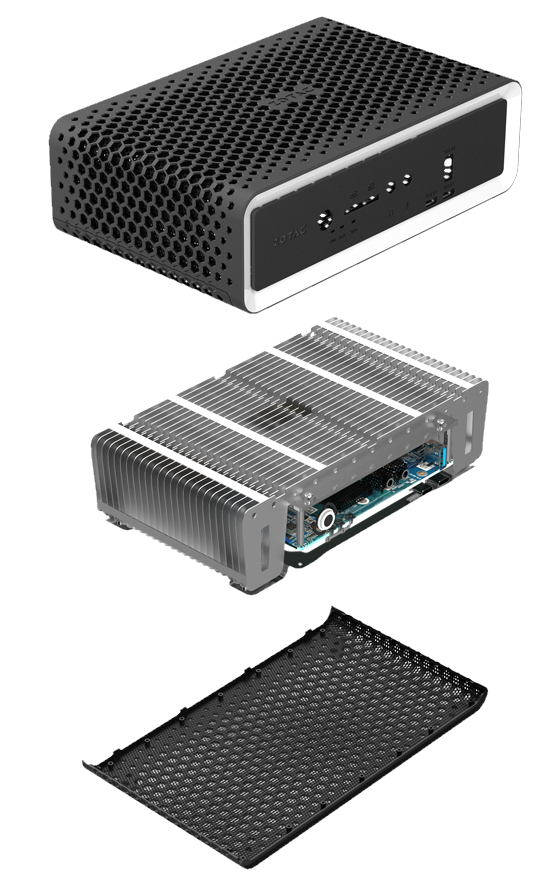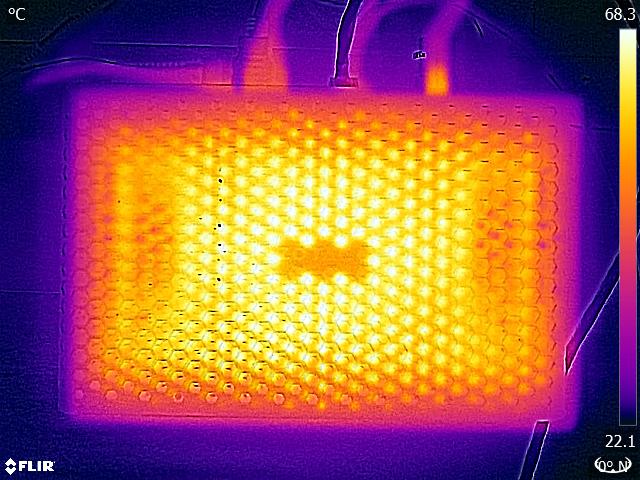Zotac ZBOX CI662 nano Fanless mini-PC Review: Second Stab at Silencing Succeeds
by Ganesh T S on January 5, 2021 8:00 AM EST- Posted in
- Systems
- Intel
- ZOTAC
- Fanless
- HTPC
- ZBOX
- Passive Cooling
- Mini-PC
- Comet Lake
Miscellaneous Aspects and Concluding Remarks
Prior to wrapping up this review, there are few different aspects of the Zotac CI662 nano that need to be addressed. These include external thermal profile, pricing and value proposition, comparisons against similar systems in the market, and things Zotac could address in future C-series systems.
External Thermal Profile
The core thermal solution employed in the ZBOX CI662 nano is the huge heat-sink that completely envelopes the board except for the underside (to allow installation of a 2.5" drive and the DDR4 SODIMMs). Unlike other passively-cooled PCs, it is not possible to directly touch the heat-sink by accident. The heat in the fins are drawn out by convection through the plastic chassis with plenty of perforations in a honeycomb pattern. The plastic casing itself doesn't get very hot. The case also has either a flat profile or rounded edges around the spots where it is usually held to access the I/O ports or power button.
After the stressful segments of our custom stress test were done, we immediately took thermal photographs using a FLIR One camera. The plastic spots in the chassis on the sides were only around 35C, though the thermal camera was able to capture temperatures of up to 68C directly on top of the case.
Additional thermal photographs with temperature ranges embedded are available in the gallery below.
Overall, the design of the system is such that it is safe enough to have within touching distance on a desk and not have to worry about accidentally burning one's hands. Access to the I/O ports is also made safe by the lack of sharp edges in the normally-accessed parts of the chassis.
Pricing and Value Proposition
The Zotac ZBOX CI662 nano has a MSRP of $550. This is $75 lesser than the $625 at which the ZBOX CI660 nano flagship of the previous generation was introduced. Perhaps, economies of scale have kicked in, as the chassis design for the two units are essentially the same. Though we pushed the price of our build to $715, it is possible to use a judicious set of components to complete the build for as low as $650. For a ready-to-use passively cooled mini-PC, this is good value for money.
It is possible to build a passively cooled version of a Frost Canyon NUC with an after-market chassis for around the same or slightly higher cost - but the efforts needed to assemble the passively-cooled case may be too time-consuming for many customers. Pre-built passively-cooled NUCs also carry a significant premium. An almost ready-to-use mini-PC like the ZBOX CI662 nano fits this target market perfectly. Relatively speaking, $550 is an affordable price tag for such a system.
Closing Thoughts
One of our primary complaints about the ZBOX CI660 nano was the coil whine / heat-sink noise - thankfully, we didn't encounter that at all in our review sample of the ZBOX CI662 nano. For all practical purposes, our review sample was a noiseless one. One of the contributing aspects to this could be the alteration of the power consumption behavior under load. In the CI660 nano, we saw the system start out with a 25W package power budget before ramping it down to the 15W point for which the thermal design is more suited. In the CI662 nano, the PL1 and PL2 limits are set such that the system ramps down to 15W quite quickly. This could also be one of the reasons why the CI660 nano churned out slightly better benchmark numbers in a few workloads compared to the CI662 nano. Sustained performance was pretty much the same for the CI662 nano and the CI660 nano.
Another aspect that ended up getting fixed (at least, in our testing environment) was HDR. We were able to get HDR working with both the HDMI and DisplayPort outputs in the CI662 nano. The system is good enough for casual HTPC use, though enthusiasts might bemoan the lack of accurate display output refresh rates and the inability to get UHD Blu-ray playback working properly (consumers might have better luck with their samples than what I had with mine on both aspects). The system doesn't seem particularly powerful for 4K HDR streaming at 60 fps, though similarly encoded local media files played back without issues (pointing to issues probably related to the browser or drivers).
Zotac still needs to fix up the curious case of high idle power consumption numbers compared to similar PCs in the market. They also need to replace the 2.5" slot with a M.2 NVMe SSD slot in future iterations - perhaps borrowing PCIe lanes direct from the CPU instead of relying on the ones from the PCH.
Zotac's value additions in terms of two extra USB 3.2 Gen 2 (10 Gbps) ports using the ASMedia ASM2142 controller is praiseworthy - though with the PCH also providing four such ports in the rear panel of the unit, we would have preferred these to be USB 3.2 Gen 2x2 (20 Gbps) ones. Zotac also provides dual LAN ports for a variety of use-cases - something that is not available in systems like the Frost Canyon NUC without using an external Thunderbolt 3/USB dock.
Overall, it can be said that the Zotac ZBOX CI662 nano is on the affordable side of the spectrum for fanless systems. The platform continues to maintain the promise it had when launched with the CI660 nano, and the core upgrades done by Intel in the follow-up to Comet Lake-U will also help Zotac to innovate further in the future. In addition to a M.2 NVMe SSD slot, we also expect to see Thunderbolt 3 ports and a more powerful Wi-Fi solution for the flagship configuration in future iterations.


















8 Comments
View All Comments
wr3zzz - Tuesday, January 5, 2021 - link
I am a huge fan of passively cooled PC but at this price point there is not much value proposition. I understand that there are no more Y-series CPU at the moment (love my HP Folio) but most notebook at $700 price point today has a silent fan profile if one were to use it as a HTPC. Also, this thing is not a looker either and for aesthetics I would rather have a notebook with display off as HTPC. For everything else its performance is no better than a notebook of equivalent value and I would trade the fan noise for actual utility of having the display and inputs in one unit.NUC has no chance if its value proposition is inferior to notebooks.
Operandi - Tuesday, January 5, 2021 - link
Yeah, I have to agree the value of this as a HTPC is absurd which is a shame as lit looks like it works quite well. And from the pics I think it actually looks alright (at least from pics) from ID perspective; much better than the ugly AF Intel NUCs.I got a pretty good deal on a older 8000 series NUC and put it in a passive Akasa case. Looks very cool, cools decently but still pretty expensive even if the NUC was way under retail.
Hulk - Tuesday, January 5, 2021 - link
My thoughts exactly. You can buy a laptop for less money. The price point is way off.Beside that huge miss it also needs a Tiger Lake processor for better performance and thermals/efficiency.
jeremyshaw - Tuesday, January 5, 2021 - link
I would even argue as a forward looking HTPC, the lack of Tiger Lake kills it. No hardware AV1 decode on these old Skylake+++ CPUs.Jorgp2 - Tuesday, January 5, 2021 - link
There's always the Atom based NUCs if you just want an HTPC.Hopefully the Tremont based NUCs will have 4K 10bit HDR output this time.
DigitalFreak - Tuesday, January 5, 2021 - link
I need a NUC form factor PC with support for DisplayPort 1.4. So far the only one I've found is the ASUS PN50, and it's a bit on the chunky side. Intel was supposed to come out with the Gen 11 NUCs with Xe graphics in December, but that didn't happen.satai - Tuesday, January 5, 2021 - link
There are boutique options like quietpc.com but it isn't a cheap option.Anyway I agree with you - I wouldn't buy a new device without 4k@120 support.